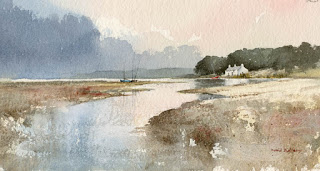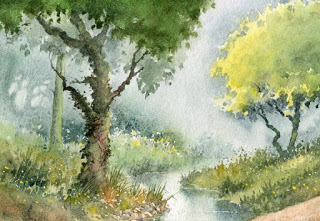It’s really heart-breaking to see some of the problems besetting the world at the moment, which put into perspective my frustrations at not being able to travel. In many ways we are seeing the best and the worst of humanity, and we wonder how it will all end. While art is giving so many people a great relief from all this misery, I know some artists are finding it difficult to concentrate on painting at the moment.
If you are finding it hard to get going then consider doing a few minutes of quiet meditation before you begin to think about what you would like to paint. I am not an expert on meditation but I do sometimes retire to a quiet spot – usually the studio – where I visualise myself back in some of the lovely locations I’ve explored and sketched, doing this for 5 or 10 minutes, helping to get myself in the mood. You may like to try it with some gentle music, or even some more lively stuff if you wish. When I do this I often start dancing and swinging the brush around more vigorously and my audience starts to get nervous at this spectacle – when I go out to the studio in the morning I am greeted raucously by them, the adulating noise often being terrific as I open the door. This is especially loud if I am carrying a bag, as the sheep think I’ve got food for them!
I’ve put together another scene for you to paint from if you wish, and I will show you my version in about ten to 14 days’ time. This scene is Llyn Mymbyr in Snowdonia, with the Plas y Brenin Mountain Centre just left of centre. You can leave the building out if you wish, just show the trees at that point. My painting will be from slightly to the right, and will include a crag descending into the right-hand side of the lake as shown in the second photograph.
Unfortunately my photographs are not filed with any precision, so I often struggle to find suitable matches, unless I’ve only recently done the painting. It takes quite some time to organise one of these mini projects. Working from more than one photograph or sketch is common and helps us introduce additional features like these crags, so this is a good exercise. Try to introduce more light and colour into the work, as the scene as it stands is rather dull, and feel free to change the tonal values where you feel this would enhance your composition.
If you don’t feel up to producing a full painting at the moment then try little sketches or small vignettes, perhaps simple experimenting with one or two techniques. Stay safe!






